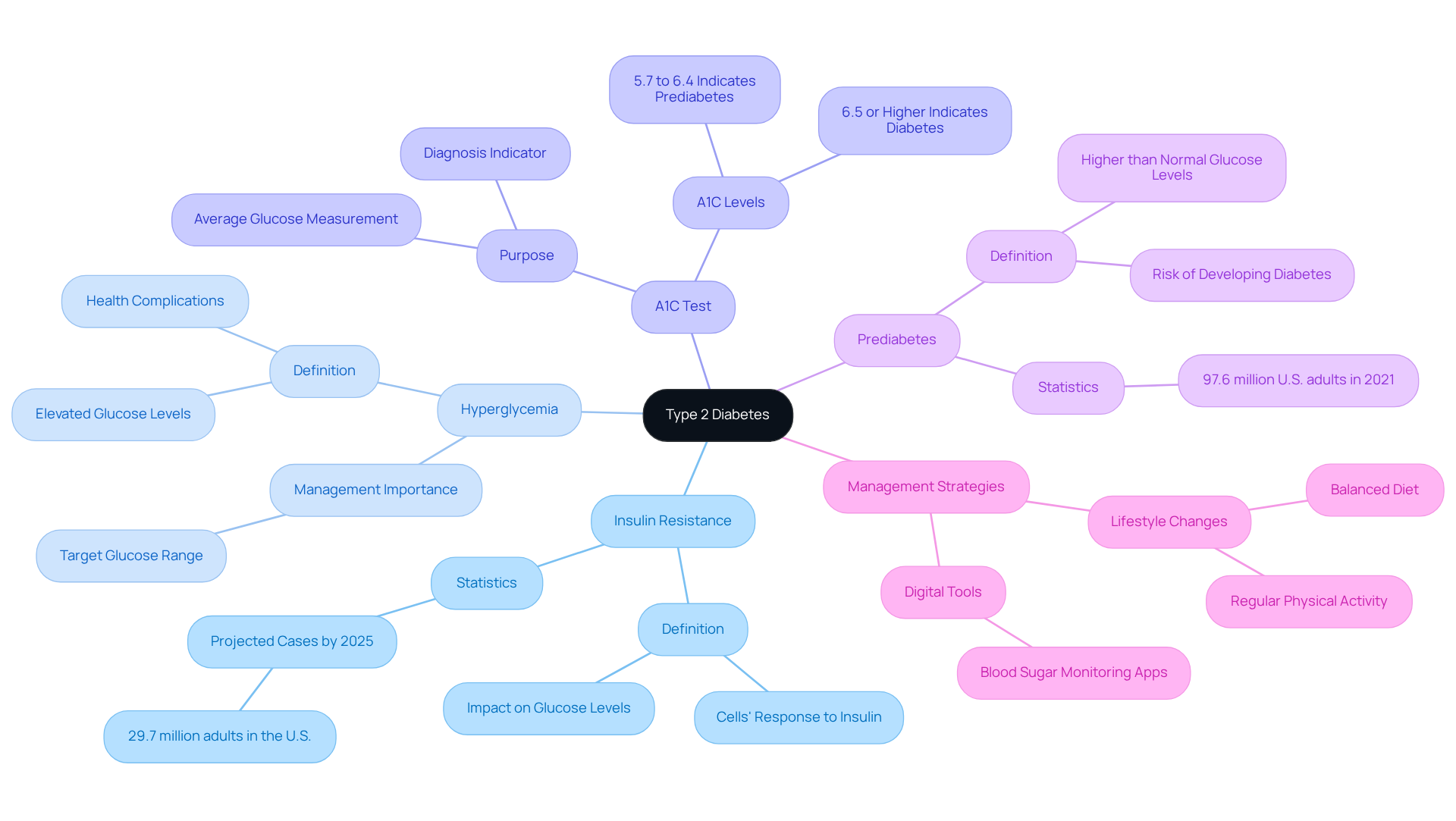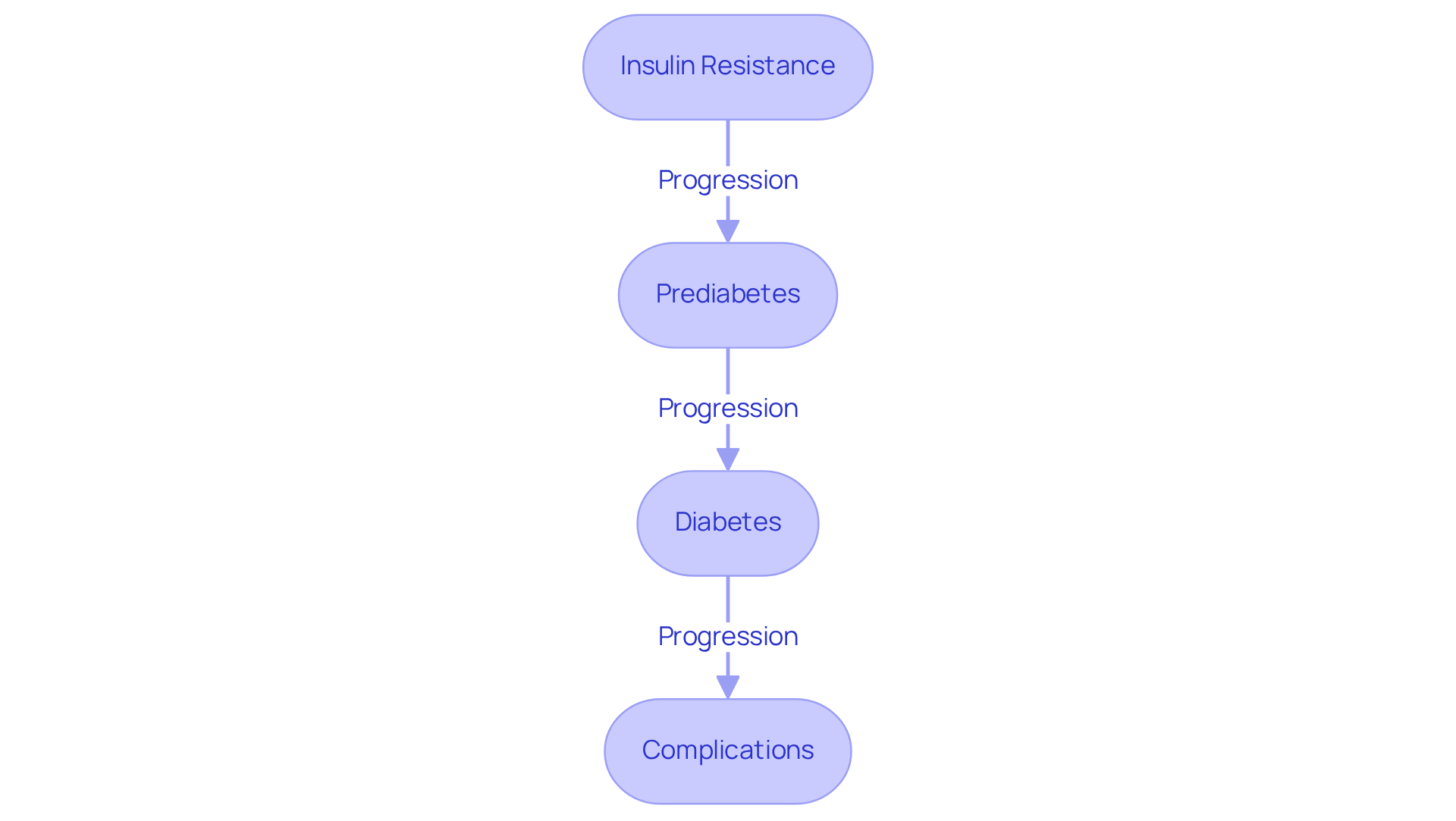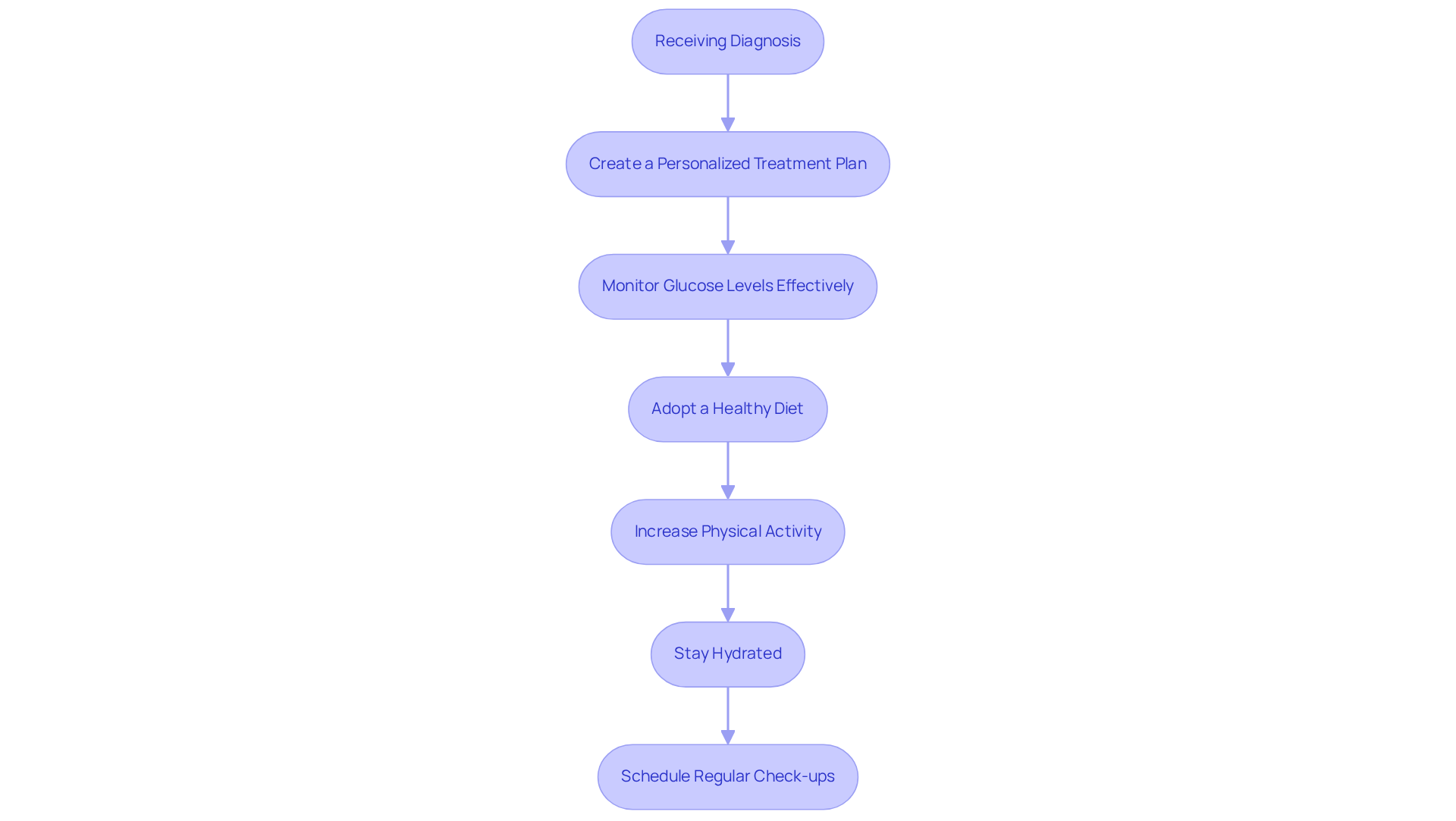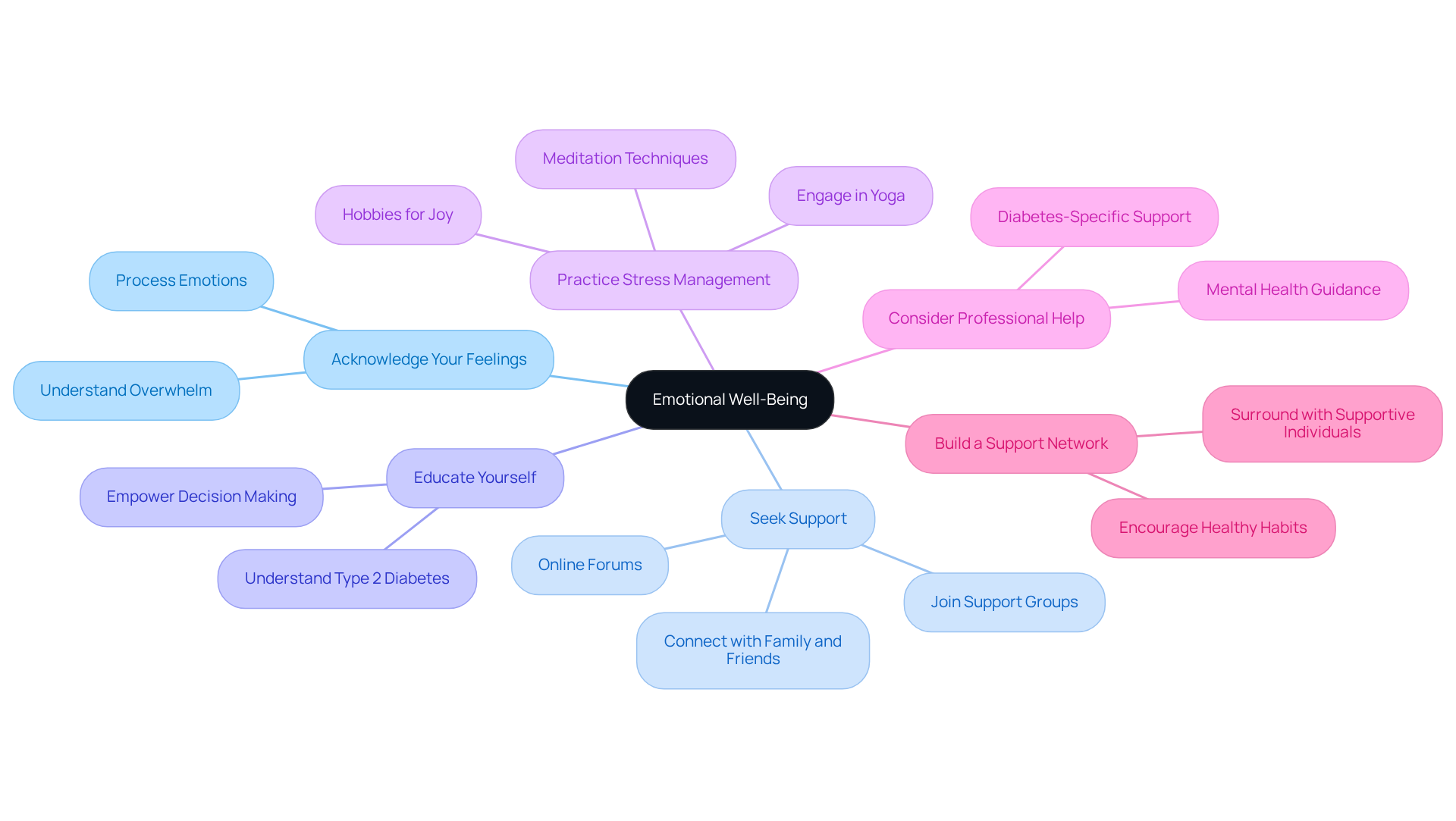Overview
Type 2 diabetes can feel overwhelming, as it is primarily characterized by insulin resistance, leading to elevated glucose levels. It's essential to understand key concepts such as hyperglycemia and the A1C test for effective management. Remember, you're not alone in this journey; many have walked this path and found ways to navigate it successfully.
This article emphasizes the importance of:
- Lifestyle changes
- Regular monitoring
- Emotional support
as crucial strategies for managing your condition and preventing complications. It's understandable to feel uncertain at times, but education and proactive care can empower you to take control of your health. We are here to support you every step of the way.
Consider reaching out for resources that can provide guidance and community support. Sharing your experiences with others can foster connection and understanding, reminding you that you are not alone in your journey. Together, we can navigate the complexities of diabetes with compassion and care.
Introduction
Understanding the complexities of Type 2 Diabetes is more crucial than ever. With projections suggesting that nearly 30 million adults in the U.S. will be diagnosed by 2025, it's natural to feel overwhelmed. This condition, characterized by insulin resistance and elevated glucose levels, poses significant health risks if not managed properly.
As you explore essential concepts, management strategies, and the emotional impact of this diagnosis, remember that you are not alone in this journey. We aim to empower you to take control of your health and well-being. However, with so much information available, how can you navigate the overwhelming landscape of diabetes care and ensure effective management?
It's understandable to feel uncertain, but together, we can find clarity and support. Let's embark on this journey, equipped with knowledge and resources to help you thrive.
Define Type 2 Diabetes: Key Concepts and Terminology
It is important to understand what to know about type 2 diabetes, a long-term condition primarily characterized by insulin resistance, where the body's cells do not respond effectively to insulin, resulting in increased glucose levels. Understanding key terms is vital for effective management and communication with your healthcare providers:
- Insulin Resistance: This condition happens when the body's cells struggle to respond adequately to insulin, leading to higher blood glucose levels. It’s concerning that by 2025, around 29.7 million adults in the U.S. are expected to be diagnosed with diabetes, which emphasizes what to know about type 2 diabetes, as many will experience insulin resistance.
- Hyperglycemia: Elevated glucose levels define hyperglycemia, a common aspect of diabetes that can lead to serious health complications if not managed properly. Current definitions emphasize the importance of maintaining glucose levels within a target range to prevent long-term damage.
- A1C Test: This test measures average glucose levels over the past 2-3 months and is essential for diagnosing and monitoring diabetes. An A1C level of 6.5% or higher indicates diabetes, while levels between 5.7% and 6.4% suggest prediabetes.
Prediabetes is identified by glucose levels that are higher than normal but not high enough for a diabetes diagnosis, highlighting what to know about type 2 diabetes, as it indicates an increased risk of developing the condition. In 2021, it was estimated that 97.6 million U.S. adults had prediabetes, emphasizing what to know about type 2 diabetes and the need for early intervention.
Real-world examples of managing insulin resistance include lifestyle changes such as adopting a balanced diet rich in whole foods, engaging in regular physical activity, and using digital tools to monitor blood sugar levels. These strategies not only assist in managing insulin resistance but also empower you to take control of your health effectively.
As T2DSolutions prepares to launch as a comprehensive resource center for diabetes education and community support, it is essential for newly diagnosed patients to understand what to know about type 2 diabetes in order to navigate their diabetes journey. You're not alone in this journey, and we are here to support you every step of the way. Stay tuned for more information and resources that will soon be available!

Explain the Progression of Type 2 Diabetes: Understanding Changes Over Time
Diabetes mellitus 2 is a progressive condition that typically unfolds through several phases. At T2DSolutions, we genuinely care about providing you with comprehensive resources and community support to help you navigate this journey:
-
Insulin Resistance: Initially, your body may become unresponsive to insulin, leading the pancreas to produce more insulin to maintain normal glucose levels. This stage is crucial, as around 70% of individuals with prediabetes will progress to Diabetes 2 if no lifestyle changes are made.
-
Prediabetes: As insulin production struggles to keep pace with rising glucose levels, prediabetes occurs. Often, this condition is asymptomatic, making regular screening vital for early detection and intervention.
-
Over time, glucose levels may escalate to the diabetic range, and the pancreas may produce less insulin. This stage is characterized by persistent hyperglycemia, which can result in serious health complications if not managed effectively.
-
Complications: Without proper management, complications such as cardiovascular disease, neuropathy, and kidney damage can arise. Diabetes is a leading cause of new cases of blindness and kidney failure, which underscores the importance of early intervention and ongoing care.
Understanding this progression is part of what to know about type 2 diabetes, highlighting the necessity for regular monitoring and proactive lifestyle adjustments to manage blood sugar levels effectively. Recent studies reveal that lifestyle changes, including diet and exercise, can significantly reduce the risk of moving from prediabetes to diabetes mellitus. This emphasizes the importance of education and community support in diabetes management. Remember, you're not alone in this journey; we are here to support you every step of the way.

Outline Essential Management Strategies: Steps to Take After Diagnosis
Receiving a Type 2 Diabetes diagnosis can feel overwhelming, but understanding what to know about type 2 diabetes and implementing effective management strategies is essential for maintaining your health and preventing complications. Here are some important steps to consider:
-
Create a Personalized Treatment Plan: It's vital to collaborate with your healthcare team to develop a treatment plan that suits your unique needs. This may include medications, lifestyle changes, and regular monitoring to help you feel more in control.
-
Monitor Glucose Levels Effectively: Regular glucose monitoring is crucial. Using home testing kits can help you understand how your body responds to different foods and activities. Research shows that efficient oversight can lead to significant improvements in glycemic regulation, with programs demonstrating a decrease in hemoglobin A1c values by an average of 0.5% over three months.
-
Adopt a Healthy Diet: Focusing on a balanced diet that includes whole grains, lean proteins, healthy fats, and a variety of fruits and vegetables can make a difference. Current dietary guidelines suggest reducing processed foods and added sugars, which can worsen glucose spikes.
-
Increase Physical Activity: Aim for at least 150 minutes of moderate aerobic activity each week, such as brisk walking or cycling. Regular physical activity not only helps manage weight but also enhances insulin sensitivity, making you feel more energized.
-
Stay Hydrated: Remember to drink plenty of water throughout the day and limit sweetened beverages, which can lead to increased glucose levels.
-
Schedule Regular Check-ups: Regular appointments with your healthcare provider are essential for monitoring your condition and making necessary adjustments to your management plan. Early diagnosis and ongoing management can significantly reduce the risk of complications associated with diabetes.
By embracing these strategies, you can improve your blood sugar control and overall health, which is essential in understanding what to know about type 2 diabetes and paving the way for a better quality of life. Remember, you're not alone in this journey; we are here to support you every step of the way.

Address Emotional Well-Being: Coping with the Diagnosis and Building Support Networks
Receiving a diagnosis of Type 2 Diabetes can be a daunting experience, and it's completely normal to feel a whirlwind of emotions when learning what to know about type 2 diabetes. Focusing on your emotional well-being is essential for managing this condition effectively. Here are some compassionate strategies to support your emotional health:
-
Acknowledge Your Feelings: It’s understandable to experience feelings of overwhelm, anxiety, or even anger after your diagnosis. Allow yourself the space to process these emotions; it’s a vital part of your journey.
-
Seek Support: Connecting with family, friends, or support groups can provide a valuable outlet for sharing experiences and emotions. Consider joining online forums as well, where you can foster a sense of community and feel less isolated.
-
Educate yourself on what to know about type 2 diabetes, as this knowledge can significantly reduce fear and uncertainty. By understanding your condition, you empower yourself to make informed decisions about your health.
-
Practice Stress Management: Engage in activities that help alleviate stress, such as yoga, meditation, or hobbies that bring you joy. These practices can enhance your emotional resilience and well-being.
-
Consider Professional Help: If feelings of anxiety or depression persist, seeking guidance from a mental health professional who understands diabetes-related issues can be incredibly beneficial. You're not alone in this journey.
-
Build a Support Network: Surround yourself with supportive individuals who encourage healthy habits and provide emotional backing. Research shows that strong support networks can lead to better diabetes management outcomes.
By prioritizing emotional well-being and fostering supportive relationships, you can enhance your resilience and improve what to know about type 2 diabetes. Remember, we are here to support you every step of the way.

Conclusion
Understanding Type 2 diabetes is essential for effective management and prevention of complications. This condition, primarily characterized by insulin resistance and elevated glucose levels, requires individuals to be informed about its key concepts, progression, and management strategies. With projections indicating a significant rise in diabetes diagnoses by 2025, awareness and education are more important than ever.
This article delves into the fundamental aspects of Type 2 diabetes, including the definitions of critical terms like insulin resistance and hyperglycemia. It outlines the progression of the disease, from prediabetes to potential complications, emphasizing the importance of early intervention. Furthermore, it provides essential management strategies, such as:
- Creating personalized treatment plans
- Monitoring glucose levels
- Adopting a healthy diet
- Prioritizing emotional well-being through support networks
Ultimately, taking proactive steps in understanding and managing Type 2 diabetes can lead to improved health outcomes. By fostering knowledge and community support, individuals can navigate their diabetes journey with confidence. Embracing these insights not only empowers personal health management but also highlights the collective responsibility to raise awareness and support those affected by this condition. You're not alone in this journey, and we are here to support you every step of the way.
Frequently Asked Questions
What is type 2 diabetes?
Type 2 diabetes is a long-term condition primarily characterized by insulin resistance, where the body's cells do not respond effectively to insulin, resulting in increased glucose levels.
What is insulin resistance?
Insulin resistance occurs when the body's cells struggle to respond adequately to insulin, leading to higher blood glucose levels.
What is hyperglycemia?
Hyperglycemia is defined as elevated glucose levels, which is a common aspect of diabetes and can lead to serious health complications if not managed properly.
What is the A1C test?
The A1C test measures average glucose levels over the past 2-3 months and is essential for diagnosing and monitoring diabetes. An A1C level of 6.5% or higher indicates diabetes, while levels between 5.7% and 6.4% suggest prediabetes.
What is prediabetes?
Prediabetes is identified by glucose levels that are higher than normal but not high enough for a diabetes diagnosis, indicating an increased risk of developing type 2 diabetes.
How many adults in the U.S. are affected by diabetes and prediabetes?
By 2025, around 29.7 million adults in the U.S. are expected to be diagnosed with diabetes, and in 2021, it was estimated that 97.6 million U.S. adults had prediabetes.
What are some strategies to manage insulin resistance?
Strategies to manage insulin resistance include adopting a balanced diet rich in whole foods, engaging in regular physical activity, and using digital tools to monitor blood sugar levels.
What resources are available for newly diagnosed patients with type 2 diabetes?
T2DSolutions is preparing to launch as a comprehensive resource center for diabetes education and community support to help newly diagnosed patients navigate their diabetes journey.



